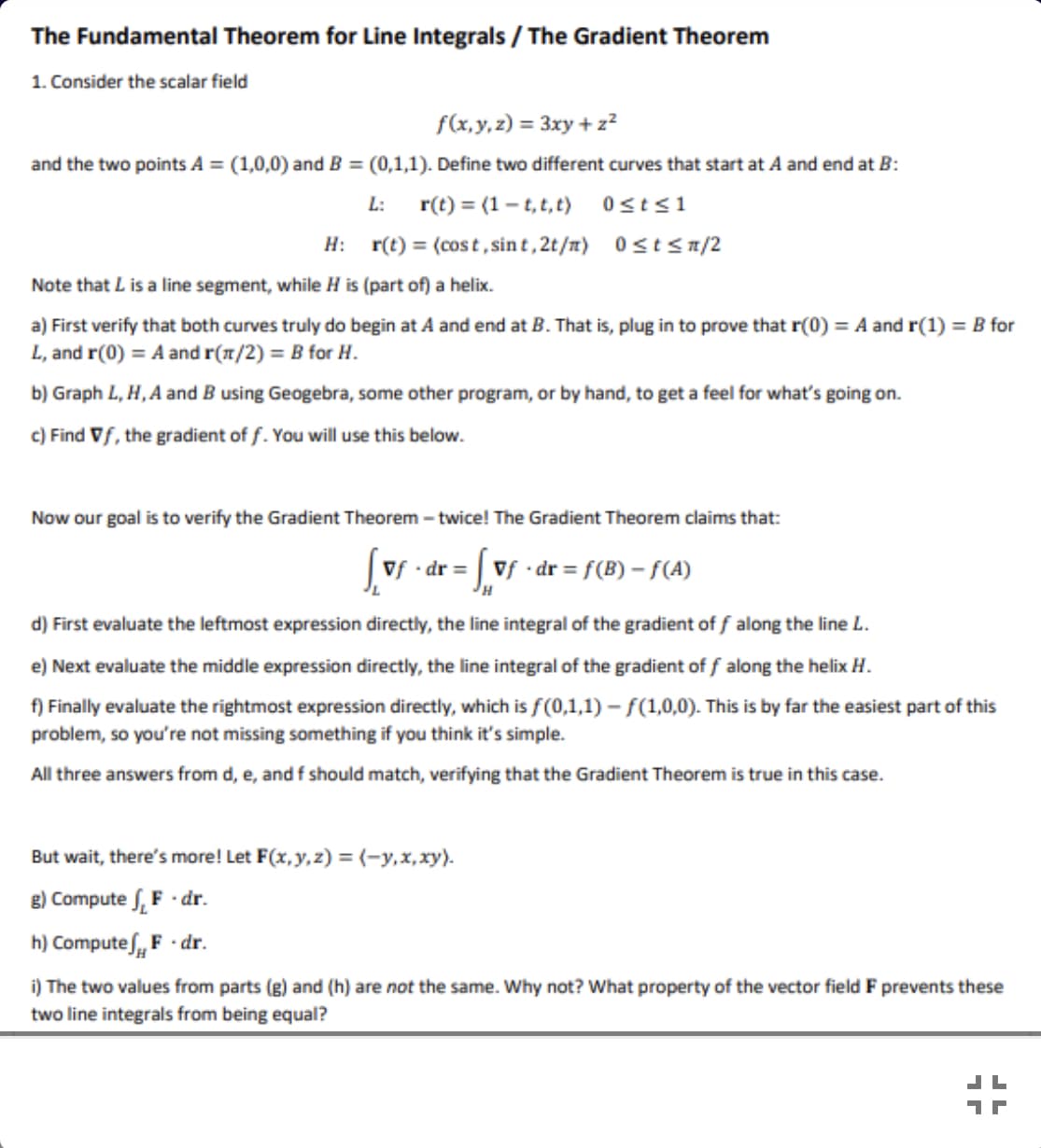The Fundamental Theorem for Line Integrals / The Gradient Theorem 1. Consider the scalar field f(x,y, z) = 3xy + z² and the two points A = (1,0,0) and B = (0,1,1). Define two different curves that start at A and end at B: L: r(t) = (1 – t, t, t) Osts1 H: r(t) = (cost,sin t, 2t/m) 0stSa/2 Note that L is a line segment, while H is (part of) a helix. a) First verify that both curves truly do begin at A and end at B. That is, plug in to prove that r(0) = A and r(1) = B for L, and r(0) = A and r(1/2) = B for H. b) Graph L, H, A and B using Geogebra, some other program, or by hand, to get a feel for what's going on. c) Find Vf, the gradient of f. You will use this below. Now our goal is to verify the Gradient Theorem - twice! The Gradient Theorem claims that: · dr = | vf •dr = f(B) – f(A) d) First evaluate the leftmost expression directly, the line integral of the gradient of f along the line L. e) Next evaluate the middle expression directly, the line integral of the gradient of f along the helix H. f) Finally evaluate the rightmost expression directly, which is f(0,1,1) – f(1,0,0). This is by far the easiest part of this problem, so you're not missing something if you think it's simple. All three answers from d, e, and f should match, verifying that the Gradient Theorem is true in this case. But wait, there's more! Let F(x, y, z) = (-y,x,xy). 8) Compute S, F - dr. h) Compute ,F - dr. i) The two values from parts (g) and (h) are not the same. Why not? What property of the vector field F prevents these two line integrals from being equal?
Family of Curves
A family of curves is a group of curves that are each described by a parametrization in which one or more variables are parameters. In general, the parameters have more complexity on the assembly of the curve than an ordinary linear transformation. These families appear commonly in the solution of differential equations. When a constant of integration is added, it is normally modified algebraically until it no longer replicates a plain linear transformation. The order of a differential equation depends on how many uncertain variables appear in the corresponding curve. The order of the differential equation acquired is two if two unknown variables exist in an equation belonging to this family.
XZ Plane
In order to understand XZ plane, it's helpful to understand two-dimensional and three-dimensional spaces. To plot a point on a plane, two numbers are needed, and these two numbers in the plane can be represented as an ordered pair (a,b) where a and b are real numbers and a is the horizontal coordinate and b is the vertical coordinate. This type of plane is called two-dimensional and it contains two perpendicular axes, the horizontal axis, and the vertical axis.
Euclidean Geometry
Geometry is the branch of mathematics that deals with flat surfaces like lines, angles, points, two-dimensional figures, etc. In Euclidean geometry, one studies the geometrical shapes that rely on different theorems and axioms. This (pure mathematics) geometry was introduced by the Greek mathematician Euclid, and that is why it is called Euclidean geometry. Euclid explained this in his book named 'elements'. Euclid's method in Euclidean geometry involves handling a small group of innately captivate axioms and incorporating many of these other propositions. The elements written by Euclid are the fundamentals for the study of geometry from a modern mathematical perspective. Elements comprise Euclidean theories, postulates, axioms, construction, and mathematical proofs of propositions.
Lines and Angles
In a two-dimensional plane, a line is simply a figure that joins two points. Usually, lines are used for presenting objects that are straight in shape and have minimal depth or width.
Can I please get help with g) h) and I)

Trending now
This is a popular solution!
Step by step
Solved in 2 steps









